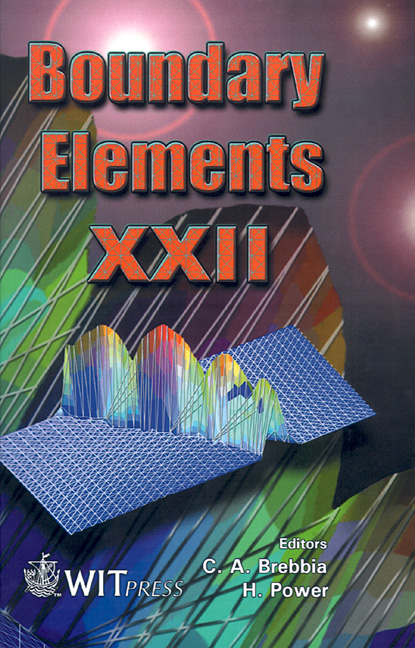Bi-cubic Spline Functions In BEM Computations
Of Electrostatic HV-fields
Author(s)
C. Vetter
Abstract
The Boundary-Element-Method (BEM) is traditionally linked to electrostatic HV-
problems for calculating the field stress of diverse electrical configurations. This
paper describes an approach using bi-cubic spline functions as boundary elements
for modeling complex, three-dimensional geometries and computing the electric
field.
Following well-known BEM, the boundary surfaces of high-voltage arrangements
are divided into a large number of patches. Standard elements, e.g. cylinders,
cones, toroidals, spheres, triangles and rectangles are provided for simulating sim-
ple configurations, but they become unusable in case of arbitrary, non-rotational
symmetric geometries because of their limited approximation power. In order to
model a complex 3D-surf ace in an optimum way, bi-cubic spline functions are
used to approximate the given contour. Appropriate met
Keywords
Related Book
Other papers in this volume
Warning (2)
: foreach() argument must be of type array|object, null given [in
/var/www/dce7ae55-385b-4ffa-8595-3ec5e61ff110/public_html/app/templates/Papers/view.php, line
364]
Code
$counter = '0';
foreach ($paper['book']['Paper'] as $otherPaper) {
if ((!empty($otherPaper['name'])) && ($counter < '7') && ($otherPaper['available'] == 1)) {
Cake\Error\ErrorTrap->handleError() /var/www/dce7ae55-385b-4ffa-8595-3ec5e61ff110/public_html/app/templates/Papers/view.php, line 364
/var/www/dce7ae55-385b-4ffa-8595-3ec5e61ff110/public_html/app/vendor/cakephp/cakephp/src/View/View.php /var/www/dce7ae55-385b-4ffa-8595-3ec5e61ff110/public_html/app/vendor/cakephp/cakephp/src/View/View.php, line 1188
Cake\View\View->_evaluate() /var/www/dce7ae55-385b-4ffa-8595-3ec5e61ff110/public_html/app/vendor/cakephp/cakephp/src/View/View.php, line 1145
Cake\View\View->_render() /var/www/dce7ae55-385b-4ffa-8595-3ec5e61ff110/public_html/app/vendor/cakephp/cakephp/src/View/View.php, line 785
Cake\View\View->render() /var/www/dce7ae55-385b-4ffa-8595-3ec5e61ff110/public_html/app/vendor/cakephp/cakephp/src/Controller/Controller.php, line 712
Cake\Controller\Controller->render() /var/www/dce7ae55-385b-4ffa-8595-3ec5e61ff110/public_html/app/vendor/cakephp/cakephp/src/Controller/Controller.php, line 516
Cake\Controller\Controller->invokeAction() /var/www/dce7ae55-385b-4ffa-8595-3ec5e61ff110/public_html/app/vendor/cakephp/cakephp/src/Controller/ControllerFactory.php, line 166
Cake\Controller\ControllerFactory->handle() /var/www/dce7ae55-385b-4ffa-8595-3ec5e61ff110/public_html/app/vendor/cakephp/cakephp/src/Controller/ControllerFactory.php, line 141
Cake\Controller\ControllerFactory->invoke() /var/www/dce7ae55-385b-4ffa-8595-3ec5e61ff110/public_html/app/vendor/cakephp/cakephp/src/Http/BaseApplication.php, line 362
Cake\Http\BaseApplication->handle() /var/www/dce7ae55-385b-4ffa-8595-3ec5e61ff110/public_html/app/vendor/cakephp/cakephp/src/Http/Runner.php, line 86
Cake\Http\Runner->handle() /var/www/dce7ae55-385b-4ffa-8595-3ec5e61ff110/public_html/app/vendor/cakephp/cakephp/src/Http/Middleware/CsrfProtectionMiddleware.php, line 169
Cake\Http\Middleware\CsrfProtectionMiddleware->process() /var/www/dce7ae55-385b-4ffa-8595-3ec5e61ff110/public_html/app/vendor/cakephp/cakephp/src/Http/Runner.php, line 82
Cake\Http\Runner->handle() /var/www/dce7ae55-385b-4ffa-8595-3ec5e61ff110/public_html/app/vendor/cakephp/cakephp/src/Http/Middleware/BodyParserMiddleware.php, line 157
Cake\Http\Middleware\BodyParserMiddleware->process() /var/www/dce7ae55-385b-4ffa-8595-3ec5e61ff110/public_html/app/vendor/cakephp/cakephp/src/Http/Runner.php, line 82
Cake\Http\Runner->handle() /var/www/dce7ae55-385b-4ffa-8595-3ec5e61ff110/public_html/app/vendor/cakephp/cakephp/src/Routing/Middleware/RoutingMiddleware.php, line 118
Cake\Routing\Middleware\RoutingMiddleware->process() /var/www/dce7ae55-385b-4ffa-8595-3ec5e61ff110/public_html/app/vendor/cakephp/cakephp/src/Http/Runner.php, line 82
Cake\Http\Runner->handle() /var/www/dce7ae55-385b-4ffa-8595-3ec5e61ff110/public_html/app/vendor/cakephp/cakephp/src/Routing/Middleware/AssetMiddleware.php, line 69
Cake\Routing\Middleware\AssetMiddleware->process() /var/www/dce7ae55-385b-4ffa-8595-3ec5e61ff110/public_html/app/vendor/cakephp/cakephp/src/Http/Runner.php, line 82
Cake\Http\Runner->handle() /var/www/dce7ae55-385b-4ffa-8595-3ec5e61ff110/public_html/app/vendor/cakephp/cakephp/src/Error/Middleware/ErrorHandlerMiddleware.php, line 115
Cake\Error\Middleware\ErrorHandlerMiddleware->process() /var/www/dce7ae55-385b-4ffa-8595-3ec5e61ff110/public_html/app/vendor/cakephp/cakephp/src/Http/Runner.php, line 82
Cake\Http\Runner->handle() /var/www/dce7ae55-385b-4ffa-8595-3ec5e61ff110/public_html/app/vendor/cakephp/debug_kit/src/Middleware/DebugKitMiddleware.php, line 60
DebugKit\Middleware\DebugKitMiddleware->process() /var/www/dce7ae55-385b-4ffa-8595-3ec5e61ff110/public_html/app/vendor/cakephp/cakephp/src/Http/Runner.php, line 82
Cake\Http\Runner->handle() /var/www/dce7ae55-385b-4ffa-8595-3ec5e61ff110/public_html/app/vendor/cakephp/cakephp/src/Http/Runner.php, line 60
Cake\Http\Runner->run() /var/www/dce7ae55-385b-4ffa-8595-3ec5e61ff110/public_html/app/vendor/cakephp/cakephp/src/Http/Server.php, line 104
Cake\Http\Server->run() /var/www/dce7ae55-385b-4ffa-8595-3ec5e61ff110/public_html/app/webroot/index.php, line 37
[main]






